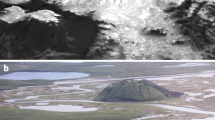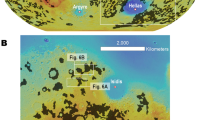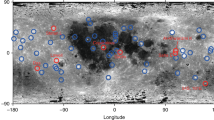Abstract
The decay of the martian atmosphere—which is dominated by carbon dioxide—is a component of the long-term environmental change on Mars1 from a climate that once allowed rivers to flow2,3,4,5,6 to the cold and dry conditions of today. The minimum size of craters serves as a proxy for palaeopressure of planetary atmospheres, because thinner atmospheres permit smaller objects to reach the surface at high velocities and form craters7,8,9. The Aeolis Dorsa region near Gale crater on Mars contains a high density of preserved ancient craters interbedded with river deposits11 and thus can provide constraints on atmospheric density at the time of fluvial activity. Here we use high-resolution images and digital terrain models10 from the Mars Reconnaissance Orbiter to identify ancient craters in deposits in Aeolis Dorsa that date to about 3.6 Gyr ago and compare their size distribution with models of atmospheric filtering of impactors12,13. We obtain an upper limit of 0.9 ± 0.1 bar for the martian atmospheric palaeopressure, rising to 1.9 ± 0.2 bar if rimmed circular mesas—interpreted to be erosionally-resistant fills or floors of impact craters—are excluded. We assume target properties appropriate for desert alluvium14: if sediment had rock-mass strength similar to bedrock at the time of impact, the paleopressure upper limit increases by a factor of up to two. If Mars did not have a stable multibar atmosphere at the time that the rivers were flowing—as suggested by our results—then a warm and wet CO2/H2O greenhouse2 is ruled out, and long-term average temperatures were most likely below freezing.
This is a preview of subscription content, access via your institution
Access options
Subscribe to this journal
Receive 12 print issues and online access
$259.00 per year
only $21.58 per issue
Buy this article
- Purchase on Springer Link
- Instant access to full article PDF
Prices may be subject to local taxes which are calculated during checkout



Similar content being viewed by others
References
Mahaffy, P. R. et al. Abundance and isotopic composition of gases in the martian atmosphere from the Curiosity rover. Science 341, 263–266 (2013).
Pollack, J. B., Kasting, J. F., Richardson, S. M. & Poliakoff, K. The case for a wet, warm climate on early Mars. Icarus 71, 203–224 (1987).
Segura, T. L., Toon, O. B. & Colaprete, A. Modeling the environmental effects of moderate-sized impacts on Mars. J. Geophys. Res. 113, E11007 (2008).
Tian, F. et al. Photochemical and climate consequences of sulfur outgassing on early Mars. Earth Planet. Sci. Lett. 295, 412–418 (2010).
Forget, F. et al. 3D modelling of the early martian climate under a denser CO2 atmosphere: Temperatures and CO2 ice clouds. Icarus 222, 81–99 (2013).
Kite, E. S., Halevy, I., Kahre, M. A., Wolff, M. J. & Manga, M. Seasonal melting and the formation of sedimentary rocks on Mars, with predictions for the Gale crater mound. Icarus 223, 181–210 (2013).
Chappelow, J. E. & Golombek, M. P. Event and conditions that produced the iron meteorite Block Island on Mars. J. Geophys. Res. 115, E00F07 (2010).
Wood, C. A. et al. Impact craters on Titan. Icarus 206, 344–344 (2010).
Herrick, R. R., Sharpton, V. L., Malin, M. C., Lyons, S. N. & Feely, K. in Venus II (eds Bougher, S. W., Hunten, D. M. & Phillips, R. J.) 1015–1046 (Univ. Arizona Press, 1997) (catalogue as v3; updated by R. R. Herrick in http://www.lpi.usra.edu/resources/vc/vchome.html)
Burr, D. M. et al. Inverted fluvial features in the Aeolis/Zephyria Plana region, Mars: Formation mechanism and initial paleodischarge estimates. J. Geophys. Res. 115, E07011 (2010).
Kirk, R. L. et al. Ultrahigh resolution topographic mapping of Mars with MRO HiRISE stereo images: Meter-scale slopes of candidate Phoenix landing sites. J. Geophys. Res. 113, E00A24 (2008).
Williams, J-P., Pathare, A. & Aharonson, O. Modeling Small Impact Populations on Mars, EPSC Abstracts, Vol. 7 (European Planetary Science Congress, (2012).
Popova, O., Nemtchinov, I. & Hartmann, W. K. Bolides in the present and past martian atmosphere and effects on cratering processes. Meteorit. Planet. Sci. 36, 905–925 (2003).
Holsapple, K. A. & Housen, K. R. A crater and its ejecta: An interpretation of Deep Impact. Icarus 191, 586–597 (2007).
Kopparapu, R. K. et al. Habitable zones around main-sequence stars: New estimates. Astrophys. J. 765, 131 (2013).
Lammer, H. et al. Outgassing history and escape of the martian atmosphere and water inventory. Space Sci. Rev. 174, 113–154 (2013).
Manning, C. V., McKay, C. P. & Zahnle, K. J. Thick and thin models of the evolution of carbon dioxide on Mars. Icarus 180, 38–59 (2006).
Manga, M., Patel, A., Dufek, J. & Kite, E. S. Wet surface and dense atmosphere on early Mars inferred from the bomb sag at Home Plate, Mars. Geophys. Res. Lett. 39, L01202 (2012).
Vasavada, A. R., Milavec, T. J. & Paige, D. A. Microcraters on Mars: Evidence for past climate variations. J. Geophys. Res. 98, 3469–3476 (1993).
Kite, E. S., Lucas, A. S. & Fassett, C. I. Pacing early Mars river activity: Embedded craters in the Aeolis Dorsa region imply river activity spanned ≳(1–20 Myr). Icarus 225, 850–855 (2013).
Melosh, H. J. in Impact Cratering: A Geologic Process 1989).
Dundas, C. M., Keszthelyi, L. P., Bray, V. J. & McEwen, A. S. Role of material properties in the cratering record of young platy-ridged lava on Mars. Geophys. Res. Lett. 37, L12203 (2010).
Holsapple, K. A. The scaling of impact processes in planetary sciences. Ann. Rev. Earth Planet. Sci. 21, 333–373 (1993).
Urata, R. A. & Toon, O. B. Simulations of the martian hydrologic cycle with a general circulation model: Implications for the ancient martian climate. Icarus 226, 229–250 (2013).
Ramirez, R. M. et al. Warming early Mars with CO2 and H2 . Nature Geosci. 7, 59–63 (2014).
Catling, D. C. in Encyclopedia of Paleoclimatology and Ancient Environments (ed Gornitz, V.) 66–75 (Springer, 2009).
Van Berk, W., Fu, Y. & Ilger, J-M. Reproducing early martian atmospheric carbon dioxide partial pressure by modeling the formation of Mg–Fe–Ca carbonate identified in the Comanche rock outcrops on Mars. J. Geophys. Res. 117, E10008 (2012).
Som, S., Catling, D., Harnmeijer, J., Polivka, P. & Buick, R. Air density 2.7 billion years ago limited to less than twice present levels by fossil raindrop imprints. Nature 484, 359–362 (2012).
McEwen, A. S. & Bierhaus, E. B. The importance of secondary cratering to age constraints on planetary surfaces. Ann. Rev. Earth Planet. Sci. 34, 535–567 (2006).
Werner, S. C., Ivanov, B. A. & Neukum, G. Theoretical analysis of secondary cratering on Mars and an image-based study on the Cerberus Plains. Icarus 200, 406–417 (2009).
Robbins, S. J., Di Achille, G. & Hynek, B. M. The volcanic history of Mars: High-resolution crater-based studies of the calderas of 20 volcanoes. Icarus 211, 1179–1203 (2011).
Cassata, W. et al. Trapped Ar isotopes in meteorite ALH 84001 indicate Mars did not have a thick ancient atmosphere. Earth Planet. Sci. Lett. 221, 461–465 (2012).
Acknowledgements
We thank I. Daubar, J. Dufek, B. Ehlmann, W. Fischer, V. Ganti, I. Halevy, J. Kasting, K. Lewis, M. Manga, R. Ramirez, M. Rice, A. Soto and R. Wordsworth for preprints and discussions. We thank the HiRISE team and the CTX team. This work was financially supported by an O.K. Earl Fellowship (to E.S.K.) and by the US taxpayer through NASA grants NNX11AF51G (to O.A.) and NNX11AQ64G (to J-P.W.).
Author information
Authors and Affiliations
Contributions
E.S.K. designed research, picked craters, carried out the data–model comparison and drafted the main text. J-P.W. wrote the forward model of impactor–atmosphere interactions. A.L. built the digital terrain models and wrote the corresponding Supplementary text. O.A. supervised research. All authors contributed to the interpretation of the results and to the revisions.
Corresponding author
Ethics declarations
Competing interests
The authors declare no competing financial interests.
Supplementary information
Supplementary Information
Supplementary Information (PDF 9756 kb)
Rights and permissions
About this article
Cite this article
Kite, E., Williams, JP., Lucas, A. et al. Low palaeopressure of the martian atmosphere estimated from the size distribution of ancient craters. Nature Geosci 7, 335–339 (2014). https://doi.org/10.1038/ngeo2137
Received:
Accepted:
Published:
Issue Date:
DOI: https://doi.org/10.1038/ngeo2137
This article is cited by
-
Coupling and interactions across the Martian whole atmosphere system
Nature Geoscience (2023)
-
The Long-Term Evolution of the Atmosphere of Venus: Processes and Feedback Mechanisms
Space Science Reviews (2022)
-
A coupled model of episodic warming, oxidation and geochemical transitions on early Mars
Nature Geoscience (2021)
-
Did Mars Possess a Dense Atmosphere During the First $\sim400$ Million Years?
Space Science Reviews (2021)
-
Geologic Constraints on Early Mars Climate
Space Science Reviews (2019)



